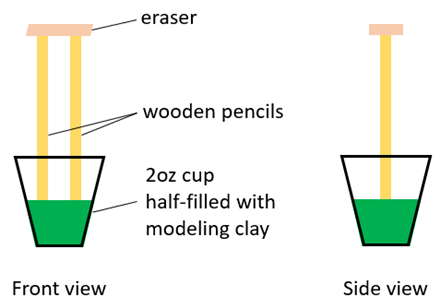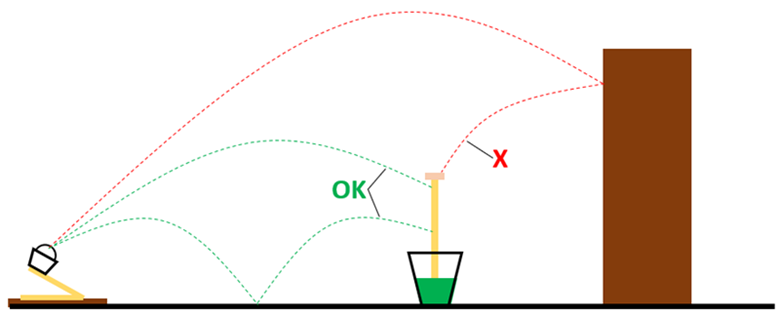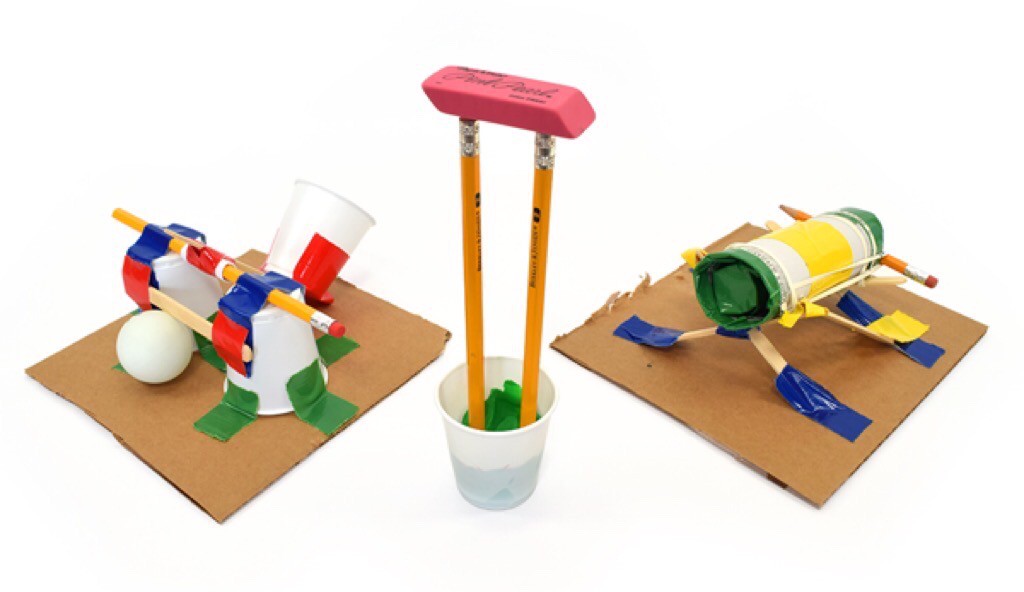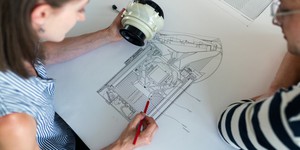Abstract
In this cricket-inspired engineering challenge, you will build a machine to launch a ball and knock down a target (called a wicket). How many times can you knock down the wicket in three minutes?
Teachers, lesson plan versions of this challenge are also available.
Summary
This engineering challenge is based on an internal competition designed by employees at Fluor Corporation.
Objective
Use craft supplies to build a machine that can launch a ball at a target (called a wicket in this challenge) and knock it down.
Introduction
If you are familiar with the sport of cricket, you may know that part of the game involves using a ball to knock two small bails (horizontal sticks) off of three larger stumps stuck into the ground. Together, the bails and stumps are called a wicket. This Engineering Challenge is inspired by cricket. Your goal is to build a machine that can launch a ball at a wicket and knock it down.
This project allows you to explore some interesting topics in physics and engineering. Rather than explain these topics in detail, this background section will give you a brief overview, and then you can do more research on them using the links in the bibliography. If you are doing this engineering project for a science fair, do not worry about learning about every topic; instead, choose one to study in more detail.
First, this challenge is a great opportunity to learn about simple machines, like the lever or the inclined plane. You can also investigate more complex machines like catapults, trebuchets, or slingshots, that are used to launch projectiles. Think about how you could incorporate different aspects of these machines into your design.
Speaking of projectiles, you can use this project to learn about projectile motion. How do the initial velocity and launch angle of a projectile affect its range (distance it travels)? What trajectory (path the ball takes through the air) will make it easier to hit the wicket: a high, steep trajectory or a low, shallow trajectory?
You can also use this project to learn about energy. The ball needs kinetic energy, the energy of motion, in order to fly through the air. Where will that energy come from? It could come from elastic potential energy, the energy stored in a stretched material, like a rubber band. It could come from gravitational potential energy, the energy stored in an object that is raised up off the ground. Or, the energy could come from work that you do with your hand by exerting a force. How could your machine convert one form of energy to another?
You can also use the project to examine conservation of momentum. What happens when the light, fast-moving ping pong ball collides with the heavy, stationary eraser on top of the wicket?
Finally, you can use this project to demonstrate the engineering design process. It is unlikely that you will think of an idea for a machine, sit down and build it, and have it work perfectly on the first try. You might need to come up with multiple designs, test more than one of them, and modify the designs to improve them. This is OK—real engineers rarely get things right on the first try!
Terms and Concepts
- Simple machine
- Lever
- Inclined plane
- Catapult
- Trebuchet
- Slingshot
- Projectile motion
- Initial velocity
- Launch angle
- Range
- Trajectory
- Kinetic energy
- Elastic potential energy
- Gravitational potential energy
- Work
- Force
- Conservation of momentum
Questions
- Look at the list of items in the Materials section. How could you build a machine to launch a ball using these materials?
- What will provide the energy to launch the ball?
- How will you aim the ball at the wicket?
- Do you need to hit the eraser directly in order to knock it down? Or could you knock it down by hitting the pencils or the cup?
Bibliography
- Science Trek (n.d.). Simple Machines: Facts. Idaho Public Television. Retrieved November 22, 2019.
- Finio, B. (2017, October 16). Launch Time: The Physics of Catapult Projectile Motion. Retrieved November 22, 2019.
- Henderson, T. (n.d.). What is a projectile? The Physics Classroom. Retrieved November 22, 2019.
- Henderson, T. (n.d.). Work, Energy, and Power. The Physics Classroom. Retrieved November 22, 2019.
- Science Buddies Staff (n.d.). The Engineering Design Process. Science Buddies. Retrieved November 22, 2019.
Materials and Equipment
If you want to compare your results to those of other students who did the 2020 Engineering Challenge, you can only use the materials listed below. Each item has a maximum allowable quantity and a point cost (each) that will be deducted from your score, as described in the procedure. Note that you can cut the materials, but costs are not prorated; e.g., if you cut a piece of paper in half and only use half of it, it still costs 10 points.
| Construction Materials | ||
|---|---|---|
| Item | Maximum Quantity | Point cost (each) |
| Cardboard (max size 12"x12" or 30x30 cm) | 1 | 10 |
| 2 oz paper or plastic cup | 10 | 3 |
| Wooden craft sticks (4 ½" or 11.5 cm) | 10 | 1 |
| Wooden pencils (circular or hexagonal cross-section, approx. 7–8" or 18–20 cm length) | 10 | 1 |
| Paper (printer/copier paper, not construction paper or cardstock; letter or A4 size) | 10 | 1 |
| Rubber bands (size 32, 3" long unstretched and 1/8" wide) | 10 | 2 |
| Cardboard tube (1 unit = 1 paper towel roll or 2 toilet paper rolls) | 2 units | 9 per unit |
| Roll of clear adhesive tape (Scotch® tape or equivalent, 1/2" or 3/4" width, max length 500") | 1 | 10 |
| Duct tape (up to 90 feet total, no more than 2" wide) | 90 feet | 20 (if any used) |
| Tools and Testing Materials (no point cost) | ||
| Item | Quantity | Notes |
| Ping pong ball | 1 | |
| Ruler or measuring tape | 1 | |
| Scissors | 1 | |
| 2 oz paper or plastic cup | 1 | Used to build the wicket |
| Wooden pencils | 2 | |
| Rubber or plastic eraser (approximately 2"x1"x1/2") | 1 | |
| Modeling clay, Play Doh®, or homemade dough. | Enough to fill the 2 oz cup halfway | |
Disclaimer: Science Buddies participates in affiliate programs with Home Science Tools, Amazon.com, Carolina Biological, and Jameco Electronics. Proceeds from the affiliate programs help support Science Buddies, a 501(c)(3) public charity, and keep our resources free for everyone. Our top priority is student learning. If you have any comments (positive or negative) related to purchases you've made for science projects from recommendations on our site, please let us know. Write to us at scibuddy@sciencebuddies.org.
Experimental Procedure
The objective of the 2020 Engineering Challenge is to build a device that can launch a ping pong ball and knock an eraser off a wicket (the target) made from two pencils stuck into a cup of clay. Teams will try to knock the eraser off the wicket as many times as possible within a set time limit. If you have not already done so, watch this video for an overview of the challenge before you proceed.
Launching Device
- Device can only be built with items on the official materials list.
- Device must be free-standing and rest on the ground or a cardboard base. It cannot be taped to the ground or another object like furniture. It cannot be held up in the air or supported by a person (if you let go of it, it shouldn't fall over).
- The device must launch the ping pong ball (e.g., using a rubber band or a lever). This launching action can be activated by a person, using one or two hands (e.g., stretching a rubber band, pushing on a lever). The device cannot just support the ball while a person throws the ball (e.g., like a golf tee—the device can't just hold the ball in place while you flick it forward with your finger).
Testing
- Wicket must be built according to the diagram shown in Figure 1.
- Wicket must be placed upright, at least 1 foot from the nearest wall or obstacle (Figure 2).
- Your launching device must be a minimum of 2 feet away from the wicket (Figure 2).
- Testing may be done by a team of up to four students (e.g. one student to launch the ball, one student to retrieve the ball, one student to reset the eraser or wicket, and one student to record the number of times the eraser is knocked over).
- The ball is allowed to bounce or roll on the ground before hitting the wicket. If a ball bounces off the wall or any object (including a student) and then knocks the eraser over, that does not count (Figure 3). It does not matter if the ball hits anything after hitting the wicket.
- The ball does not need to hit the eraser directly in order to knock it down. It still counts if the ball hits the cup or the pencils and makes the eraser fall.
- For the official test to calculate your score, there is a time limit of three minutes to see how many times you can knock the eraser off the wicket.
- You can do as many official tests as you want to try and get a higher score, but you can only submit one high score per team.
Do you have a question that is not answered by these rules? See the FAQ.
 Image Credit: Ben Finio. Science Buddies / Science Buddies
Image Credit: Ben Finio. Science Buddies / Science Buddies
Figure 1. The wicket is made from a 2 oz plastic or paper cup half-filled with modeling clay. Two pencils are stuck into the clay vertically, 1 inch apart, and an eraser is balanced on top. The goal is to launch a ping pong ball at the wicket and knock the eraser down.
 Image Credit: Ben Finio. Science Buddies / Science Buddies
Image Credit: Ben Finio. Science Buddies / Science Buddies
Figure 2. Minimum distances between the launcher, wicket, and other obstacles. The launching device must be at least 2 feet from the wicket. The wicket must be at least 1 foot from any nearby obstacles like walls or furniture.
 Image Credit: Ben Finio. Science Buddies / Science Buddies
Image Credit: Ben Finio. Science Buddies / Science Buddies
Figure 3. Illustration of how the ball can bounce before hitting the wicket. The ball can bounce off the floor multiple times, or roll on the floor, before hitting the wicket. The shot does not count if the ball bounces off other obstacles, like a wall or person, before hitting the wicket.
Design
Before you start building anything, it is a good idea to brainstorm some different designs. Try sketching your designs out on paper. Which design will work best given the rules and materials you are allowed to use? Which design do you think will be the most reliable? Think about these questions and select one designs to move forward with.
Build
Once you have decided on a design, it is time to start building it. You might find out that your design "on paper" does not work as planned when you try to build it in the real world. That is OK! You do not have to stick to your original plan. You can make modifications to your design, or even start over with something completely new.
Test
Once you have built your ball-launching device, set up your wicket (see Figure 1) and try it out. This is your opportunity to identify weak spots in your design and find things that can be improved. Try launching the ball at the wicket to see if you can knock the eraser down. Remember that you do not have to hit the eraser directly. The ball is allowed to bounce off the floor or hit the cup or pencils. Here are some things to consider:
- How accurately can you launch the ball? Take 10 shots. How many times did you knock the eraser down?
- How quickly can you retrieve the ball and re-load your launching device? Your official test will be timed, so you want to do this as quickly as possible.
- How sturdy is your launching device? Will it hold up to repeated launches without falling apart?
Based on the results of your testing, you may want to go back and make changes to your design before you do your official test.
Official Test
- Set up your wicket and launching device. Make sure you follow the minimum distances outlined in the rules.
- Start your stopwatch and immediately start launching the ball to try and knock the eraser down.
- If you miss, retrieve the ball and launch again.
- If you knock the eraser down, quickly retrieve the ball, reset the wicket, and launch again.
- Keep track of how many times you knock the eraser down.
- Stop your stopwatch after 3 minutes. Move on to the next section to calculate your score.
Scoring
Calculate your score using this equation:
The materials cost is the total point cost for all materials used in your final design (Table 1). Materials used during test/prototyping that you did not use in your final design do not count.
Troubleshooting
For troubleshooting tips, please read our FAQ: Cricket Wicket Knockdown Challenge.
Ask an Expert
Global Connections
The United Nations Sustainable Development Goals (UNSDGs) are a blueprint to achieve a better and more sustainable future for all.
Variations
Did you have fun with this engineering project? Check out the previous Engineering Challenges!
Frequently Asked Questions (FAQ)
Careers
If you like this project, you might enjoy exploring these related careers:
Related Links
- Science Fair Project Guide
- Other Ideas Like This
- Physics Project Ideas
- Mechanical Engineering Project Ideas
- Engineering Challenge Project Ideas
- My Favorites














